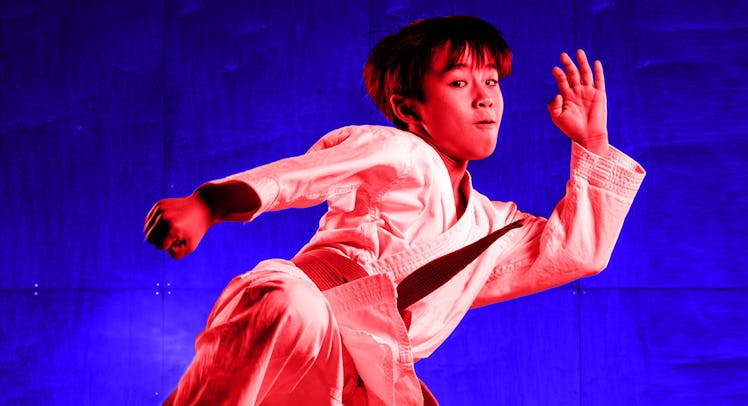How to Get Your Kid Started in Martial Arts
It all begins with basic strength training.

At five years old, my son Tony is rubbish at defending himself physically. He, of course, doesn’t share this assessment of his own skill. As both the founder and holder of the highest rank of Tony-itsu (a golden belt with 10,000 golden trophies), Tony has the swagger of Conor McGregor. Alas, he has the skill of an eggplant. Soon there will come a time when he’ll have to face facts and start seriously training, but not quite yet.
For a variety of mundane reasons, I am the only one in our family who attends our neighborhood dojo, Sun Dojo. There I practice Brazilian jiu-jitsu with my fellow sweaty judo-ka. Though they do have a Brooklyn Ninja program for kids Tony’s age, he’s not quite ready to commit. (Or, honestly, his mother isn’t quite ready to commit to shlepping him there every week.) But I recently asked the co-owner (and mother of two daughters) of Sun Dojo, Professor Laurel Carroll, for some easy tips to get Tony on the way from being a ony-itsu sensei to actually getting on the mat.
Start By Teaching Them They’re Worth Defending
“The cornerstone for self-defense is to be able to speak up when necessary,” says Professor Laurel. A kid can have all the technique in the world but if they don’t learn to stand up for themselves, they’ll never use it. “When I ask kids if they think they’re worth defending,” she tells me, “you’d be amazed by how many kids don’t raise their hands.” The real work of teaching a kid self-defense is teaching them they are a self worth defending, that is, regardless of gender, raising a kid with Big Dick Energy.
Move on to Basic Strength Training
The important thing, says Professor Laurel, is to keep a kid’s physical and mental limitations in mind when they’re starting off. “Though kids are natural grapplers,” she tells me, “often they’re weaker in their upper body and core.” So before you start teaching your four-year-old juji gatame and single-leg takedowns, do some basic strength training like holding a plank or using monkey bars to develop upper-body strength first. They can even start gently pumping iron, though avoid one-rep maximums. But in general, horsing around, at the playground and at home, is laying the natural foundation for strength. “We really congratulated our daughter for doing a muscle-up out of her crib,” says Professor Laurel.
Keep Instructions Very Very Basic
As far as teaching actual technique goes, before the age of six or seven, kids have a hard time processing complex commands. “What we try to do,” explains Professor Laurel, “is break down techniques to one command at a time.” If it’s a kicking drill, she says, “we start off with commands like ‘Lift your leg. Bend your knee. Now kick!'” Avoid drills like “Kick ten times!” or anything that relies on the kid holding a complex chain of actions in his or her mind.
Introduce These Simple Moves
Bearing in mind that these must be broken down into bite-size steps, start with a base of simple striking techniques like jabs and crosses. The same holds true for kids as it does adults: straight punches are faster than hooks and haymakers. But above all, keep the wrist strong, the fist tight, and the thumb on the outside of the fingers.
Disguise Lupine Technique in Sheep-y Games
As far as actual skills go, Professor Laurel takes the Jessica Seinfeld approach: disguising nutritious BJJ techniques as a game. “If we’re teaching them back control, we’re calling it bear grip. If we’re teaching takedowns, we’ll call it ‘Tackle the Giant.’ They think they’re playing, but they’re learning how to get their hooks in, how to take someone’s backs.” But even if you yourself aren’t a trained judoka, generalized roughhousing starts teaching the basic grammar. For instance, I’ve taught Tony through basic play the advantages of full-mount as opposed to closed guard by letting him pummel my fat face with his tiny hands when he achieves it. Similarly, I’ve instilled in him a revulsion against giving me his back by ⏤ GENTLY⏤ pretending to apply RNC‘s until he taps.
This article was originally published on